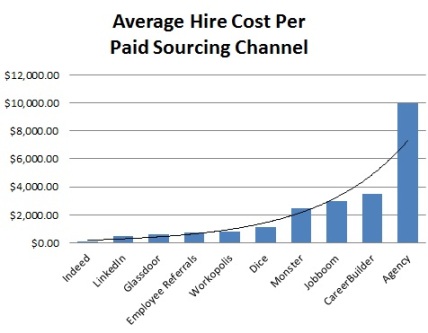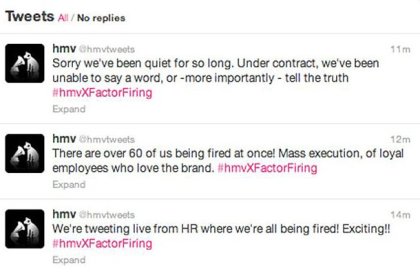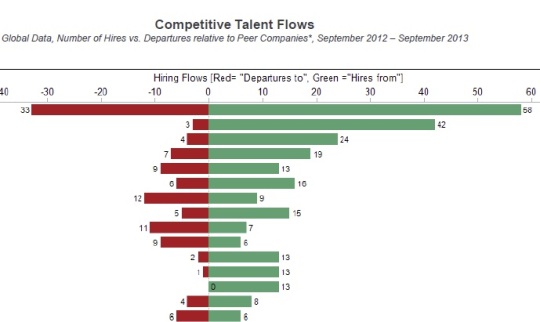2014 is shaping up to be a year that will disrupt the way traditional HR functions operate. As technology, social media and data continue to become interwoven into the fabric of the workplace, HR must start to think and act like business functions by using data and insights to drive their strategy.
 Not that long ago, thought leaders called upon companies to treat HR as a strategic partner alongside the CEO, CFO, CIO, etc. to bring insights to human capital within the organization. HR, like business functions will need to rely on data, trending and analysis to assess and shape new initiatives. Over the last few years, business functions (marketing, sales, legal, communications, products, operations, compliance; just to name a few) have expanded their data sources to include social media insights, internet analytics, search and traffic patterns. That coupled with “listening” to what people are saying about the company on social platforms provides key information on developing and/or tweaking strategies. This data is also extremely useful for HR to gage satisfaction, employee insights and dissatisfaction.
Not that long ago, thought leaders called upon companies to treat HR as a strategic partner alongside the CEO, CFO, CIO, etc. to bring insights to human capital within the organization. HR, like business functions will need to rely on data, trending and analysis to assess and shape new initiatives. Over the last few years, business functions (marketing, sales, legal, communications, products, operations, compliance; just to name a few) have expanded their data sources to include social media insights, internet analytics, search and traffic patterns. That coupled with “listening” to what people are saying about the company on social platforms provides key information on developing and/or tweaking strategies. This data is also extremely useful for HR to gage satisfaction, employee insights and dissatisfaction.
You may wonder how HR can use data for strategy when most of the data is based on operational transactions. To that I say, follow the lead of the business. HR can use a combination of operational, internet and social media metrics to analyze recruitment volume, sourcing effectiveness, candidate experience, retention and brand impact.
Here are a few ideas on how you can put data to work to help build your strategy:
1. Recruitment (Talent Sourcing)- Building your workforce is critical to achieving the organizations’ goals
a. Measures: Source of Application, Source of Hire, Cost of Sourcing Channels
Data Source: RMS/ATS
Strategy: What channels have proven to be most effective for hires? Are there any shifts or trends that are emerging quarter over quarter or year over year? Invest your sourcing dollars wisely. Analyze data over time so you can see what sources are yielding and providing good ROI. Your data will guide you to make sound, informed decisions.

b. Measure: Recruiter capacity
Data Source: RMS/ATS
Strategy: Do you have enough people to execute the work? Analyze recruiter capacity against volume and complexity. Be prepared to dig deeper to speak to efficiency of work. Recruiter capacity impacts both service levels and the quality of output they can provide in a realistic time frame.
2. Talent Sourcing Interactions- impacts brand and consumer opinions about the organization
a. Measure: Candidate experience
Data Sources: Glassdoor, Indeed, Facebook, Twitter, etc.
Strategy: As social recruitment becomes more dominant, candidate experience is playing a more critical role impacting attraction. Like it or not candidates’ feedback about their employers are becoming more prevalent and visible online, whether the employer has a social media presence or not. It’s important to understand and assess chatter as more candidates rely on authentic feedback to make employment and product decisions about the organization. Organizations that embrace feedback and make improvements not only impact talent sourcing, but may also impact bottom line sales.

b. Measure: Manager experience, Recruiter Performance
Data Source: Survey
Strategy: How do businesses know if their products or services add value? Feedback about the service and its value is critical to fostering good working relations to achieve the organizations goals. Use manager feedback to fine tune your service offering. Identify areas for improvement and acknowledge and reward great service.
3. Talent Management – retention is critical to building and sustaining human capital in the organization
a. Measure: Retention
Data Sources: ERP, Performance Tools, Exit Interviews, LinkedIn
Strategy: Why are employees leaving your organization? Where are they going? Are certain departments or job functions prone to lower retention than others? Analyzing data will provide insight on which companies are attracting your talent and what jobs they are moving into. Social media has made it easy to get that information. Channels like LinkedIn can run talent analytics on employee changes (coming and going) to help you understand your competition.

b. Measure: Employee experience
Data Sources: Glassdoor, Indeed, Facebook, Twitter, etc; Engagement Survey, Internal Crowdsourcing
Strategy: The ability to solicit feedback from employees has never been easier for HR Functions. With internal and external social media and collaboration tools available it’s quick and simple to get a sense of what’s working and what isn’t. Canned annual engagement surveys may feel like a corporate exercise rather than an employee centric forum to voice opinions or ideas. Happy and engaged employees are more likely to stay and move within your organization than those who feel they have no voice.
I hope these few examples get you excited about the possibilities that are are at your fingertips. Be cognizant that your metrics should be meaningful and actionable. Use your data to drive strategy, not file in your metrics folder!
I would love to hear about some metrics your company has used to help drive your strategy. Comment on my post or send me a tweet @annzaliebarrett

Great blog, Ann!
Thanks so much Gagandeep!